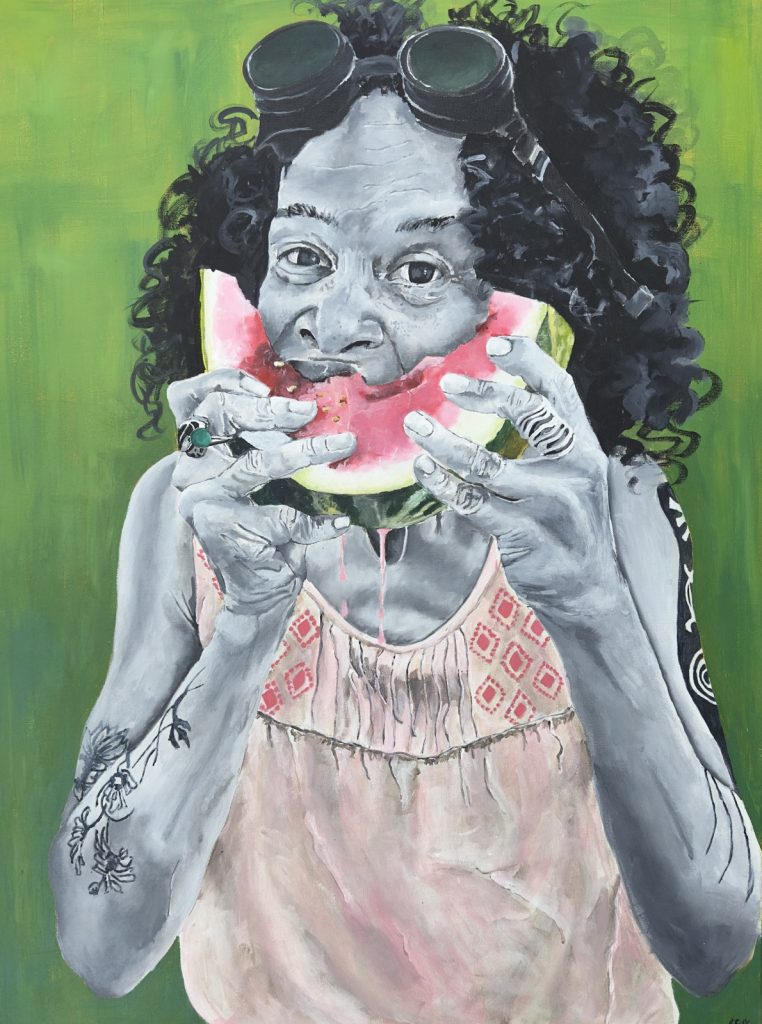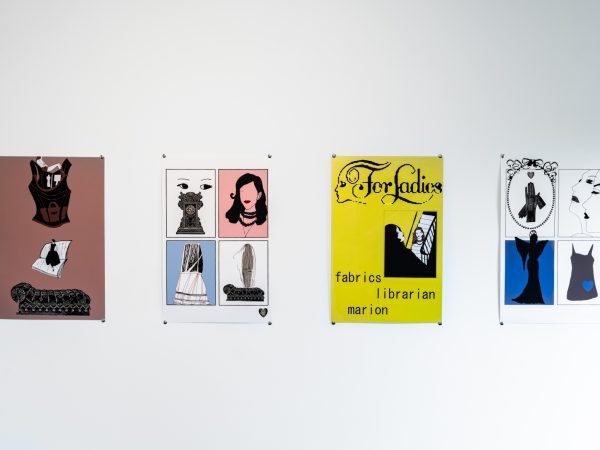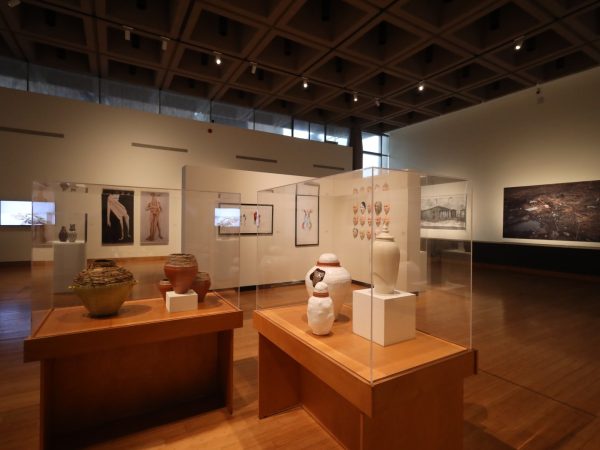
There Is No One Story of Black Girlhood is a powerful and unyielding exhibition of Rebecca Fisk’s series of self-portrait paintings. As an African Nova Scotian artist based in Mahone Bay, Fisk’s acrylic paintings reveal what may lurk beneath the dominant culture of Nova Scotia’s mask of politeness. Her work alludes to the sinister insincerity of the social environment of the East Coast. Fisk’s paintings confront and challenge hurtful stereotyping, discrimination, and racist behavior that comes part and parcel with being Black in Nova Scotia. The artist clearly establishes these works as the result of personal reflection. She positions herself as the main subject in each painting, clad in conspicuous post-apocalyptic eye goggles as an accessory. Fisk’s paintings reflect past experiences, while also looking to the future with the inclusion of the dystopian futuristic goggles.
Reclaiming harmful stereotypes is part of understanding the hardships people of African descent in Nova Scotia have typically faced, and can be a form of healing from colonial damage. For Fisk, her work suggests that healing can occur in the rejection of stereotypes. Her work explores stories shared within the Black diaspora. In her painting, Watermelon in the Afternoon, the artist conveys a sense of indulgence, controlling the context of what watermelon means to her personally. Fisk is well-aware of the connotations of an image of a Black person enjoying watermelon. The painting is subversive in that watermelon was the one of the key tropical fruits that Blacks who were poor could grow and sell, which became a negative symbol of oppression, In Watermelon in the Afternoon, Fisk portrays herself enjoying eating the watermelon, which breaks free from a sense of shame and humiliation and illustrates a form of resilience.
As Fisk put it frankly in her virtual artist talk hosted by the StFX Art Gallery: “No, I’m going to enjoy it [the watermelon] and you’re not going to ruin this for me.” Fisk’s jovial attitude of enjoying the taste of fresh sweet fruit is portrayed in the vibrant hues of the self-portrait depicting her biting into a slice of watermelon. This image is not only a reclamation, but holds the deep motivations of upholding the complexities of Black joy behind the painting. Fisk’s self-portrait painting illustrates the artist as she enjoys the luxurious colours of watermelon. The painting initially appears to be an appreciation of brightness and playful colours, but looking more deeply, Watermelon in the Afternoon becomes a somber example of how pervasive and omnipresent racism and discrimination is for people of African descent.
Fisk’s work tackles racism and discrimination more overtly with her painting, Cora. The painting depicts Cora, a child’s doll—a toy, a friend, a confidant, a lookalike—as a prized possession. Cora is what Fisk called her childhood doll. Many children received a Black doll just like the artist did. Most kids played with the Black doll naively, without much thought or care. But Fisk’s painting, Cora, is not one of playful, childish innocence. It tackles racist slurs and attitudes front on.
In Cora, the artist’s stylistic choice to deface the chalkboard background with racial slurs—hateful and hurtful words, shows how young Black boys and Black girls are discriminated against and unsafe in public school settings. The spotlight effect on the subject in the painting symbolizes that all eyes were negatively focused on Fisk as a child, who stuck out in her class (perhaps as one of the only Black children). It has always been challenging to find representative toys for non-white children, but it has never been difficult to erode all the joy from a Black child.
“One day I took her [Cora] to school for show and tell. Loved it. And one of the kids grabbed it out of my desk,” says Fisk, in her virtual artist talk. “You know, when you have the desks with the things underneath, held it up and said a few choice words, including the N-word, and said, ‘Look, look at the black doll, she’s as ugly as you are.’”
Working from stories based on childhood memories and adult experiences, Fisk primarily uses self-portraiture to portray her lived realities of growing up in a predominantly white rural community and the effects of systematic racism. Fisk earned her BFA from NSCAD in 1992, and her MFA from the University of Saskatchewan in 1997. Her work has been exhibited at the Art Gallery of Nova Scotia, Dalhousie University Art Gallery, and St. FX Art Gallery.
Reflecting on what the artist conveyed in her artist talk, I remember my own experience of being teased as a little kid with similar racial slurs thrown at me. Like many other Black people, I have tried to remove my association with Blackness, as it caused much pain by the hands of others. Yet, Fisk’s work debunks many stereotypes, as her work is masterful at conveying a feeling of familiarity and invoking empathy and understanding from the perceptive viewer.
As a Black reviewer, I have found a deeply personal connection to Fisk’s work. Through viewing Fisk’s self-portrait series There Is No One Story of Black Girlhood, I have realized that art is not just a visual stimulant for your eyes to enjoy. Art can be a shock to the system—it can strike your heart and your mind with all of the intensity of a lighting bolt. Viewing artwork such as Fisk’s, particularly through a Black lens, I am forever changed. I feel less alone. I feel more alone. I feel triumphant. I feel defeated. I am not who I once was before the visual work entered my psyche. Fisk’s work is a reminder to never forget what made me who I am today, and to honour all I’ve overcome.









Leave a Reply